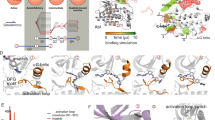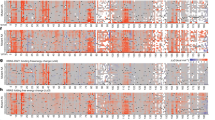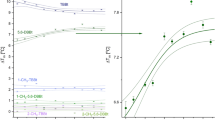Abstract
The activity of protein kinases is often regulated in an intramolecular fashion by signaling domains, which feature several phosphorylation or protein-docking sites. How kinases integrate such distinct binding and signaling events to regulate their activities is unclear, especially in quantitative terms. We used NMR spectroscopy to show how structural elements within the Abl regulatory module (RM) synergistically generate a multilayered allosteric mechanism that enables Abl kinase to function as a finely tuned switch. We dissected the structure and energetics of the regulatory mechanism to precisely measure the effects of various activating or inhibiting stimuli on Abl kinase activity. The data provide a mechanistic basis explaining genetic observations and reveal a previously unknown activator region within Abl. Our findings show that drug-resistance mutations in the Abl RM exert their allosteric effect by promoting the activated state of Abl and not by decreasing the drug affinity for the kinase.
This is a preview of subscription content, access via your institution
Access options
Access Nature and 54 other Nature Portfolio journals
Get Nature+, our best-value online-access subscription
$29.99 / 30 days
cancel any time
Subscribe to this journal
Receive 12 print issues and online access
$189.00 per year
only $15.75 per issue
Buy this article
- Purchase on Springer Link
- Instant access to full article PDF
Prices may be subject to local taxes which are calculated during checkout






Similar content being viewed by others
References
Bradley, W.D. & Koleske, A.J. Regulation of cell migration and morphogenesis by Abl-family kinases: emerging mechanisms and physiological contexts. J. Cell Sci. 122, 3441–3454 (2009).
Colicelli, J. ABL tyrosine kinases: evolution of function, regulation, and specificity. Sci. Signal. 3, re6 (2010).
Hantschel, O. Structure, regulation, signaling, and targeting of abl kinases in cancer. Genes Cancer 3, 436–446 (2012).
Greuber, E.K., Smith-Pearson, P., Wang, J. & Pendergast, A.M. Role of ABL family kinases in cancer: from leukaemia to solid tumours. Nat. Rev. Cancer 13, 559–571 (2013).
Khatri, A., Wang, J. & Pendergast, A.M. Multifunctional Abl kinases in health and disease. J. Cell Sci. 129, 9–16 (2016).
Pluk, H., Dorey, K. & Superti-Furga, G. Autoinhibition of c-Abl. Cell 108, 247–259 (2002).
Hantschel, O. et al. A myristoyl/phosphotyrosine switch regulates c-Abl. Cell 112, 845–857 (2003).
Nagar, B. et al. Structural basis for the autoinhibition of c-Abl tyrosine kinase. Cell 112, 859–871 (2003).
Harrison, S.C. Variation on an Src-like theme. Cell 112, 737–740 (2003).
Pawson, T. & Kofler, M. Kinome signaling through regulated protein-protein interactions in normal and cancer cells. Curr. Opin. Cell Biol. 21, 147–153 (2009).
Lin, J. & Arlinghaus, R. Activated c-Abl tyrosine kinase in malignant solid tumors. Oncogene 27, 4385–4391 (2008).
Ganguly, S.S. et al. c-Abl and Arg are activated in human primary melanomas, promote melanoma cell invasion via distinct pathways, and drive metastatic progression. Oncogene 31, 1804–1816 (2012).
Azam, M., Latek, R.R. & Daley, G.Q. Mechanisms of autoinhibition and STI-571/imatinib resistance revealed by mutagenesis of BCR-ABL. Cell 112, 831–843 (2003).
Sherbenou, D.W. et al. BCR-ABL SH3-SH2 domain mutations in chronic myeloid leukemia patients on imatinib. Blood 116, 3278–3285 (2010).
Nagar, B. et al. Organization of the SH3-SH2 unit in active and inactive forms of the c-Abl tyrosine kinase. Mol. Cell 21, 787–798 (2006).
Filippakopoulos, P. et al. Structural coupling of SH2-kinase domains links Fes and Abl substrate recognition and kinase activation. Cell 134, 793–803 (2008).
Lorenz, S., Deng, P., Hantschel, O., Superti-Furga, G. & Kuriyan, J. Crystal structure of an SH2-kinase construct of c-Abl and effect of the SH2 domain on kinase activity. Biochem. J. 468, 283–291 (2015).
Grebien, F. et al. Targeting the SH2-kinase interface in Bcr-Abl inhibits leukemogenesis. Cell 147, 306–319 (2011).
Kain, K.H., Gooch, S. & Klemke, R.L. Cytoplasmic c-Abl provides a molecular 'Rheostat' controlling carcinoma cell survival and invasion. Oncogene 22, 6071–6080 (2003).
Bradshaw, J.M. The Src, Syk, and Tec family kinases: distinct types of molecular switches. Cell. Signal. 22, 1175–1184 (2010).
Huse, M. & Kuriyan, J. The conformational plasticity of protein kinases. Cell 109, 275–282 (2002).
Foda, Z.H., Shan, Y., Kim, E.T., Shaw, D.E. & Seeliger, M.A. A dynamically coupled allosteric network underlies binding cooperativity in Src kinase. Nat. Commun. 6, 5939 (2015).
Kornev, A.P. & Taylor, S.S. Dynamics-driven allostery in protein kinases. Trends Biochem. Sci. 40, 628–647 (2015).
Faraldo-Gómez, J.D. & Roux, B. On the importance of a funneled energy landscape for the assembly and regulation of multidomain Src tyrosine kinases. Proc. Natl. Acad. Sci. USA 104, 13643–13648 (2007).
Yang, S., Blachowicz, L., Makowski, L. & Roux, B. Multidomain assembled states of Hck tyrosine kinase in solution. Proc. Natl. Acad. Sci. USA 107, 15757–15762 (2010).
Corbi-Verge, C. et al. Two-state dynamics of the SH3-SH2 tandem of Abl kinase and the allosteric role of the N-cap. Proc. Natl. Acad. Sci. USA 110, E3372–E3380 (2013).
Xu, R., Liu, D. & Cowburn, D. Abl kinase constructs expressed in bacteria: facilitation of structural and functional studies including segmental labeling by expressed protein ligation. Mol. Biosyst. 8, 1878–1885 (2012).
de Oliveira, G.A. et al. Intramolecular dynamics within the N-Cap-SH3-SH2 regulatory unit of the c-Abl tyrosine kinase reveal targeting to the cellular membrane. J. Biol. Chem. 288, 28331–28345 (2013).
Panjarian, S. et al. Enhanced SH3/linker interaction overcomes Abl kinase activation by gatekeeper and myristic acid binding pocket mutations and increases sensitivity to small molecule inhibitors. J. Biol. Chem. 288, 6116–6129 (2013).
Saksela, K. & Permi, P. SH3 domain ligand binding: what's the consensus and where's the specificity? FEBS Lett. 586, 2609–2614 (2012).
Barilá, D. & Superti-Furga, G. An intramolecular SH3-domain interaction regulates c-Abl activity. Nat. Genet. 18, 280–282 (1998).
Brasher, B.B. & Van Etten, R.A. c-Abl has high intrinsic tyrosine kinase activity that is stimulated by mutation of the Src homology 3 domain and by autophosphorylation at two distinct regulatory tyrosines. J. Biol. Chem. 275, 35631–35637 (2000).
Chen, S., Brier, S., Smithgall, T.E. & Engen, J.R. The Abl SH2-kinase linker naturally adopts a conformation competent for SH3 domain binding. Protein Sci. 16, 572–581 (2007).
Panjarian, S., Iacob, R.E., Chen, S., Engen, J.R. & Smithgall, T.E. Structure and dynamic regulation of Abl kinases. J. Biol. Chem. 288, 5443–5450 (2013).
Brasher, B.B., Roumiantsev, S. & Van Etten, R.A. Mutational analysis of the regulatory function of the c-Abl Src homology 3 domain. Oncogene 20, 7744–7752 (2001).
Young, M.A., Gonfloni, S., Superti-Furga, G., Roux, B. & Kuriyan, J. Dynamic coupling between the SH2 and SH3 domains of c-Src and Hck underlies their inactivation by C-terminal tyrosine phosphorylation. Cell 105, 115–126 (2001).
Lamontanara, A.J., Gencer, E.B., Kuzyk, O. & Hantschel, O. Mechanisms of resistance to BCR-ABL and other kinase inhibitors. Biochim. Biophys. Acta 1834, 1449–1459 (2013).
Dölker, N. et al. The SH2 domain regulates c-Abl kinase activation by a cyclin-like mechanism and remodulation of the hinge motion. PLoS Comput. Biol. 10, e1003863 (2014).
Volkman, B.F., Lipson, D., Wemmer, D.E. & Kern, D. Two-state allosteric behavior in a single-domain signaling protein. Science 291, 2429–2433 (2001).
Yu, B. et al. Structural and energetic mechanisms of cooperative autoinhibition and activation of Vav1. Cell 140, 246–256 (2010).
Tzeng, S.R. & Kalodimos, C.G. Protein activity regulation by conformational entropy. Nature 488, 236–240 (2012).
Akimoto, M. et al. Signaling through dynamic linkers as revealed by PKA. Proc. Natl. Acad. Sci. USA 110, 14231–14236 (2013).
Tsai, C.J. & Nussinov, R. A unified view of “how allostery works”. PLOS Comput. Biol. 10, e1003394 (2014).
Barouch-Bentov, R. & Sauer, K. Mechanisms of drug resistance in kinases. Expert Opin. Investig. Drugs 20, 153–208 (2011).
Zhang, J. et al. Targeting Bcr-Abl by combining allosteric with ATP-binding-site inhibitors. Nature 463, 501–506 (2010).
Skora, L., Mestan, J., Fabbro, D., Jahnke, W. & Grzesiek, S. NMR reveals the allosteric opening and closing of Abelson tyrosine kinase by ATP-site and myristoyl pocket inhibitors. Proc. Natl. Acad. Sci. USA 110, E4437–E4445 (2013).
Moroco, J.A. et al. Differential sensitivity of Src-family kinases to activation by SH3 domain displacement. PLoS One 9, e105629 (2014).
Shishido, T. et al. Crk family adaptor proteins trans-activate c-Abl kinase. Genes Cells 6, 431–440 (2001).
Plattner, R., Kadlec, L., DeMali, K.A., Kazlauskas, A. & Pendergast, A.M. c-Abl is activated by growth factors and Src family kinases and has a role in the cellular response to PDGF. Genes Dev. 13, 2400–2411 (1999).
Jankowski, W. et al. Domain organization differences explain Bcr-Abl's preference for CrkL over CrkII. Nat. Chem. Biol. 8, 590–596 (2012).
Bhatt, V.S., Zeng, D., Krieger, I., Sacchettini, J.C. & Cho, J.H. Binding mechanism of the N-Terminal SH3 domain of CrkII and proline-rich motifs in cAbl. Biophys. J. 110, 2630–2641 (2016).
Donaldson, L.W., Gish, G., Pawson, T., Kay, L.E. & Forman-Kay, J.D. Structure of a regulatory complex involving the Abl SH3 domain, the Crk SH2 domain, and a Crk-derived phosphopeptide. Proc. Natl. Acad. Sci. USA 99, 14053–14058 (2002).
Tanis, K.Q., Veach, D., Duewel, H.S., Bornmann, W.G. & Koleske, A.J. Two distinct phosphorylation pathways have additive effects on Abl family kinase activation. Mol. Cell. Biol. 23, 3884–3896 (2003).
Sirvent, A., Boureux, A., Simon, V., Leroy, C. & Roche, S. The tyrosine kinase Abl is required for Src-transforming activity in mouse fibroblasts and human breast cancer cells. Oncogene 26, 7313–7323 (2007).
Li, P., Martins, I.R., Amarasinghe, G.K. & Rosen, M.K. Internal dynamics control activation and activity of the autoinhibited Vav DH domain. Nat. Struct. Mol. Biol. 15, 613–618 (2008).
Wang, Q. et al. Autoinhibition of Bruton's tyrosine kinase (Btk) and activation by soluble inositol hexakisphosphate. eLife 4, e06074 (2015).
Smith, K.M., Yacobi, R. & Van Etten, R.A. Autoinhibition of Bcr-Abl through its SH3 domain. Mol. Cell 12, 27–37 (2003).
Arbesu, M. et al. The unique domain forms a fuzzy intramolecular complex in Src family kinases. Structure 25, 630–640.e4 (2017).
Maffei, M. et al. The SH3 domain acts as a scaffold for the N-terminal intrinsically disordered regions of c-Src. Structure 23, 893–902 (2015).
Lee, B.J. & Shah, N.P. Identification and characterization of activating ABL1 1b kinase mutations: impact on sensitivity to ATP-competitive and allosteric ABL1 inhibitors. Leukemia 31, 1096–1107 (2017).
Kobashigawa, Y. et al. Structural basis for the transforming activity of human cancer-related signaling adaptor protein CRK. Nat. Struct. Mol. Biol. 14, 503–510 (2007).
Saio, T., Guan, X., Rossi, P., Economou, A. & Kalodimos, C.G. Structural basis for protein antiaggregation activity of the trigger factor chaperone. Science 344, 1250494 (2014).
Huang, C., Rossi, P., Saio, T. & Kalodimos, C.G. Structural basis for the antifolding activity of a molecular chaperone. Nature 537, 202–206 (2016).
Plattner, R. et al. A new link between the c-Abl tyrosine kinase and phosphoinositide signalling through PLC-γ1. Nat. Cell Biol. 5, 309–319 (2003).
Sarkar, P., Saleh, T., Tzeng, S.R., Birge, R.B. & Kalodimos, C.G. Structural basis for regulation of the Crk signaling protein by a proline switch. Nat. Chem. Biol. 7, 51–57 (2011).
Camilloni, C., De Simone, A., Vranken, W.F. & Vendruscolo, M. Determination of secondary structure populations in disordered states of proteins using nuclear magnetic resonance chemical shifts. Biochemistry 51, 2224–2231 (2012).
Güntert, P. Automated NMR structure calculation with CYANA. Methods Mol. Biol. 278, 353–378 (2004).
Acknowledgements
The work was supported by National Institutes of Health grant GM122462 to C.G.K.
Author information
Authors and Affiliations
Contributions
T.S., P.R. and C.G.K. designed the study. T.S. performed all biochemical experiments. T.S. and P.R. recorded and analyzed the NMR data. P.R. determined the NMR structures. All authors contributed to and approved the manuscript.
Corresponding author
Ethics declarations
Competing interests
The authors declare no competing financial interests.
Integrated supplementary information
Supplementary Figure 1 NMR characterization of Abl.
(a) Domain organization and primary sequence of the first N-terminal 557 residues of Abl (isoform 1b). (b) 1H-15N HSQC spectra of select Abl RM variants. (c) 1H-15N HSQC spectrum of U-2H,15N labeled AblΔcap (left) and 1H-13C HMQC spectra of U-2H, Met-13CH3, Ile-δ1-13CH3, Leu,Val-13CH3/13CH3 labeled Abl (right).
Supplementary Figure 2 Structure analysis of the Abl assembled and extended states versus the RM activating and inhibiting states.
(a-c)The assembled state of Abl (panel a) is shown superimposed onto the inhibiting state (panel b) and onto the activating state (panel c) of the isolated Abl RM. The KD is shown as a solvent-accessible surface and the RM in ribbon. The inhibiting and activating states are colored blue and yellow, respectively. In both states the connectorSH3/2 is colored orange and the linkerSH2-KD is colored red. The inhibiting state of the isolated Abl RM superimposes very well onto the RM of the assembled structure of Abl but the activating state does not and thus is not compatible with the assembled form of Abl. (d-f) The extended state of Abl (panel d) is shown superimposed onto the inhibiting state (panel F) and onto the activating state (panel F) of the isolated Abl RM. The inhibiting state of the RM is not compatible with the extended form of Abl with the linkerSH2-KD being too short to accommodate it (e.g. Asp252 in the inhibiting state is 40 Å away from the position of this residue in the extended form of Abl). In contrast, the activating state of RM is compatible with the extended form of Abl. (g) Modeling of the extended state in Ablmyr. The black sphere denotes the extreme N-terminal Gly2 residue that is myristoylated. The structural model shows that the cap is long enough to accommodate the activating state of Abl RM on top of the N-lobe (extended state) without the need for the myristoyl to be removed from the C-lobe pocket. (h,i) Three important Tyr residues that are phosphorylated by other kinases are shown in the assembled form (panel h), wherein they are buried at the domain interfaces, and in the extended form (panel i), wherein they are all exposed and thus accessible for phosphorylation.
Supplementary Figure 3 A two-state cooperative transition between the activating and inhibiting states.
(a) Probing the assembled (inhibited) state population in Abl using the NMR resonance of Met515. This residue is located in the C lobe, at the interface with the SH2 domain, and thus it has a different chemical shift in the assembled state than in the extended state. The chemical shift change of Met515 mirrors the change experienced by Met263 (Fig. 4a). (b) Methyl NOESY data show a strong NOE between Ile164 (SH2) and Met263 (N-lobe) in AblT231R indicating that the protein adopts the extended state in solution, in agreement with the crystal data (PDB ID 4XEY). (c) Plot of the population of the Abl RM activating state in several Abl variants measured by the chemical shift change of Lys143 (Fig. 3) and of the extended state of Abl measured by the chemical shift change of Met263 (Fig. 4). The data show a strong linear relationship with a slope of 1, indicating that all of the RM molecules in the activating state form the assembled Abl state. (d) Schematic of the interconversion between the inhibiting and activating states with two residues (Asn72 and Ala75) located in capC and two residues (Tyr245 and Gly246) located in the linkerSH2-KD marked. The spectra of the four residues are shown in panels E and F. (e,f) Superimposed 1H-15N spectra of three Abl RM variants: wild type (dark blue), Abl RMP242E P249E (magenta), Abl RMΔcapPxxP (green), and Abl RMT243P (blue). The spectra of Tyr245 and Gly246 are shown in panel E and the spectra of Asn72 and Ala75 are shown in panel F. The NMR data demonstrate that residues in different regions of Abl RM all exhibit a two-state transition between the activating and inhibiting states. The effect on the population of the two states by mutations in any region of Abl RM (e.g. P242E P249E in the linkerSH2-KD) is reflected in all other regions (e.g. capC). This indicates a two-state cooperative transition of the entire Abl RM.
Supplementary Figure 4 Solution structure of RM.
Ensemble of the 20 lowest energy structures of (a) inhibiting and (b) activating states
Supplementary Figure 5 The unstructured region of Abl RM, investigated by NMR.
(a) Plot of R2/R1 ratio. 15N relaxation rates of Abl RM backbone as a function of residue number. The R2/R1 informs on the tumbling of the molecule, lower values indicate higher tumbling. (b) Secondary structure populations of Abl RM were obtained using the δ2D algorithm.
Supplementary information
Supplementary Text and Figures
Supplementary Figures 1–5 (PDF 1483 kb)
Supplementary Data Sets 1 and 2
Uncropped gels and standard deviation (SD) for the measured kinase activities from triplicate experiments (PDF 9884 kb)
Rights and permissions
About this article
Cite this article
Saleh, T., Rossi, P. & Kalodimos, C. Atomic view of the energy landscape in the allosteric regulation of Abl kinase. Nat Struct Mol Biol 24, 893–901 (2017). https://doi.org/10.1038/nsmb.3470
Received:
Accepted:
Published:
Issue Date:
DOI: https://doi.org/10.1038/nsmb.3470
This article is cited by
-
Generic nature of the condensed states of proteins
Nature Cell Biology (2021)
-
A distal regulatory region of a class I human histone deacetylase
Nature Communications (2020)
-
The role of NMR in leveraging dynamics and entropy in drug design
Journal of Biomolecular NMR (2020)



